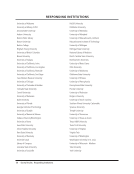186 · Representative Documents: Managing Digital Assets
WASHINGTON UNIVERSITY IN ST. LOUIS
Digital Project Support Framework
http://digital.wustl.edu/create/Digital_Project_Framework_Rev_L.doc
Scholars who wish to build digital projects must recognize the difference between
content and presentation if they hope to develop projects that are responsive to research
needs and are preservable for the long term. By properly creating data and metadata as
separable from the tools and interface through which they are accessed, the content can
be re-purposed (in part or in whole) and re-published in other formats, including future
formats not yet developed.
In order to provide optimal support for digital projects, Washington University
recognizes as a best practice the separation of content from presentation. Specific
implementation of this best practice will vary from project to project, and will likely
change in response to scholarly needs.
4 NON-PROJECT DIGITAL ASSETS
Not all digital projects properly belong to a digital collection or project. Sometimes
members of the University community may create a digital object in isolation—a scanned
photograph for classroom use, for example. In the analog past, personal collections of
photographs would often be accompanied by clues that gave such objects context, such
writing on the back identifying its subject or when or where it was taken. A significant
drawback to digital resources is that they typically have little or none of this kind of
identification. Typically, digital assets created for personal use in the classroom are only
nominally identified, if at all.
Such assets become problematic when a faculty member approaches the university
with curation or delivery requests. These classroom resources may constitute valuable
resources that deserve preservation, but the lack of documentation for such a resource
would present a significant obstacle to curation.
Washington University hopes to offer a curatorial service for these and other
orphaned resources, or non-project digital assets, in the form of a digital asset repository,
discussed later in this document. Such a repository will provide a valuable service to the
university community, but will also require faculty and other creators of such assets to
acknowledge minimal metadata and formatting standards in order to make their resources
preservable.
5 WHAT ARE THE CHALLENGES?
Three interlocking challengest must be met for successful, long-term scholarly digital
project development at the University.
1) Duration – Digital projects are created for various purposes, from limited short-
term use in a single course to long-term, broader scholarly use. To complicate
matters, the purpose of a project often changes over its lifetime. A project
originally conceived as a tool in an individual’s research may later be recognized
as a valuable resource for an entire community. Finally, and most importantly,
long-term preservation remains a stumbling block in the acceptance of projects as
long-term investments. Unlike books, which stay fairly stable after publication,
digital projects often die when the original creator retires, technology changes, or
WASHINGTON UNIVERSITY IN ST. LOUIS
Digital Project Support Framework
http://digital.wustl.edu/create/Digital_Project_Framework_Rev_L.doc
Scholars who wish to build digital projects must recognize the difference between
content and presentation if they hope to develop projects that are responsive to research
needs and are preservable for the long term. By properly creating data and metadata as
separable from the tools and interface through which they are accessed, the content can
be re-purposed (in part or in whole) and re-published in other formats, including future
formats not yet developed.
In order to provide optimal support for digital projects, Washington University
recognizes as a best practice the separation of content from presentation. Specific
implementation of this best practice will vary from project to project, and will likely
change in response to scholarly needs.
4 NON-PROJECT DIGITAL ASSETS
Not all digital projects properly belong to a digital collection or project. Sometimes
members of the University community may create a digital object in isolation—a scanned
photograph for classroom use, for example. In the analog past, personal collections of
photographs would often be accompanied by clues that gave such objects context, such
writing on the back identifying its subject or when or where it was taken. A significant
drawback to digital resources is that they typically have little or none of this kind of
identification. Typically, digital assets created for personal use in the classroom are only
nominally identified, if at all.
Such assets become problematic when a faculty member approaches the university
with curation or delivery requests. These classroom resources may constitute valuable
resources that deserve preservation, but the lack of documentation for such a resource
would present a significant obstacle to curation.
Washington University hopes to offer a curatorial service for these and other
orphaned resources, or non-project digital assets, in the form of a digital asset repository,
discussed later in this document. Such a repository will provide a valuable service to the
university community, but will also require faculty and other creators of such assets to
acknowledge minimal metadata and formatting standards in order to make their resources
preservable.
5 WHAT ARE THE CHALLENGES?
Three interlocking challengest must be met for successful, long-term scholarly digital
project development at the University.
1) Duration – Digital projects are created for various purposes, from limited short-
term use in a single course to long-term, broader scholarly use. To complicate
matters, the purpose of a project often changes over its lifetime. A project
originally conceived as a tool in an individual’s research may later be recognized
as a valuable resource for an entire community. Finally, and most importantly,
long-term preservation remains a stumbling block in the acceptance of projects as
long-term investments. Unlike books, which stay fairly stable after publication,
digital projects often die when the original creator retires, technology changes, or


































































































































































































